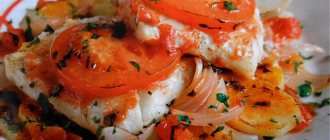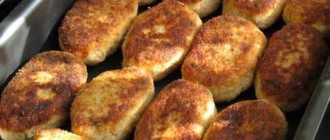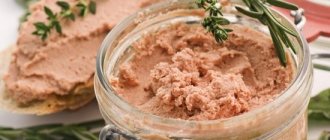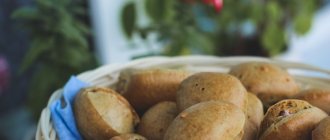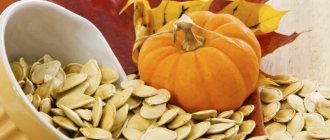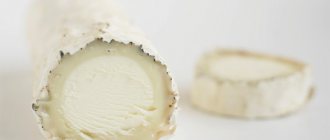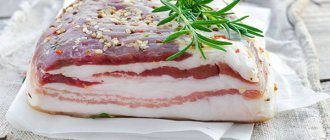Product Description
Lambert cheese is a semi-hard cheese. It has a desaturated yellow color, a pleasant, pronounced delicate creamy taste and a light aroma. We can find it on sale in three versions:
- Lambert cheese is traditional;
- Cream cheese "Lambert";
- Cheese "Lambert" Tilsiter.
The cheeses from the Lambert line differ slightly in composition and taste. They have different nutritional values per 100 grams of product:
| Product name | Proteins, in gr. | Fats, in gr. | Carbohydrates, in gr. | Energy value, in kcal. |
| Traditional | 23,8 | 30,3 | 0,0 | 378 |
| Creamy | 23,6 | 32,7 | 0,0 | 396 |
| Tilsiter | 24,2 | 25,1 | 0,0 | 340 |
Cheeses under the Lambert brand, although they differ in nutritional value, they all have a different delicate creamy taste and are distinguished by high quality production.
Cheese "Lambert": manufacturer and product characteristics
This product began to be produced in the early 2000s at one of the enterprises in the Altai Territory. In the area where cheese is produced, many succulent herbs grow. They are eaten by cows, whose milk is used to make products.
As a rule, it is not cut into pieces, since in this case the cheese can quickly lose its characteristic taste and even spoil. The exception is slices packed in a box and covered with film. This way of releasing the product makes it a good option for the holiday table. The cheese is also attractive because it has a delicate and pleasant creamy aroma. If you cut it, you can see many small holes on the surface. The product has a light yellow tint. Lambert cheese. It also produces other products: juices, mineral waters, yoghurts and so on.
Properties of cheese
One of the interesting features of Lambert is its original round patented shape. The cheese is sold in the shape of a ball, weighing 1 kg, and in small sealed packages, in pieces of ¼ circle, weighing 250 g.
The cheese attracts ordinary people with its creamy taste and delicate structure. Lambert cheese contains B vitamins, as well as vitamins C, A, D, PP, minerals, calcium and phosphorus. Of all dairy products, protein from cheese is much easier for the body to digest. Cheese increases appetite and improves the condition of the digestive system. Constant moderate consumption of hard cheese has a good effect on the condition of the skin and general well-being, thanks to minerals and vitamins.
The use of Lambert cheese in cooking
This dairy product has a mild flavor, making it ideal to eat as a stand-alone treat or as an addition to various first and second courses.
Milk cheese tastes great with black bread. This snack is much healthier and more satisfying than any sweets or fast food.
Today on the Internet you can find countless interesting recipes using it: cheese from the milk that Altai cows give can be used as an ingredient in salads, pies and snacks. If the dairy product is grated, it is good to add to pasta, sauces and omelettes.
Cheese made from the milk of Altai Lambert cows is produced by domestic cheesemakers. The product has a delicate creamy taste and pleasant aroma, which is why it is so popular among Russians.
In addition, it has a number of useful qualities, therefore it has a beneficial effect on human health. But you should eat it in doses, because, along with vitamins and amino acids, it contains a preservative and dye.
Use in cooking
Lambert cheese is widely used in cooking. It is perfect for making croissants, pizzas and puff pastries. It’s also great to use as a filling or batter for meat and fish dishes, and vegetable casseroles. Sandwiches with Lambert cheese are the most delicate delicacy. Cheese can be widely used in the preparation of sauces for dishes, added to soups and used in the preparation of pasta and all kinds of side dishes. In addition, it is a favorite snack for wine drinks. Therefore, there are many variations in the use of cheese, it all depends on the imagination and desires of the buyer.
Application
Lambert cheese goes well with many dishes. It looks great on a cheese plate. Sandwiches made with this type of rennet cheese have a unique taste. To prepare other dishes, it can be melted, grated, or cut into pieces. It is well suited for baking and hot dishes. Lambert cheese makes an excellent fondue. It is sprinkled on ready-made pasta, used when baking meat or fish, cut or grated into salads.
Market Analytics
- COVID-19 is changing the rules of the game in the cosmetics market
- Beauty of the future: cosmetic innovations 2020
- New ingredients are the driving force of the cosmetics industry
Convenient search for beauty salons on our website
Beauty salons in Moscow Beauty salons in St. Petersburg Beauty salons in Ekaterinburg Beauty salons in Novosibirsk
Latest blog posts on our website
- Naturecream / Geranium (Pelargonium) oil for skin health and beauty
- Prostye-sovety / Save on a beauty salon: procedures that can be done at home
- Naturecream / Growth Factor - brings back youth?
- Oksana-Lezina / 3 effective abdominal exercises from a fitness instructor for beginners
- Prostye-sovety / Making perfect curls at home
- Prostye-sovety / Which hair removal method to choose
- Naturecream / Wrinkles Puppets
- Naturecream / PEPHA-TIGHT - instant skin lifting
- Naturecream / Blue light - a danger to the skin
- Naturecream / Cocoa Butter – A treat for the skin
Latest forum topics on our website
- Mrs._Smith / Badly sunburned! What to do?((
- Ice / Is it necessary to combine fitness classes with a diet?
- Antonova / What can be used for hair loss?
- Radio operatorKat / Who was on a protein diet?
- Suzanna / Mesotherapy on the face
Other articles in this section
| Adyghe cheese The mountainous regions of the Caucasus are considered to be the birthplace of Adyghe cheese. There it is still considered a dish of traditional cuisine. Moreover, it has been prepared for many centuries in most Mediterranean countries. Adyghe cheese is classified as a soft cheese. Cheese, mozzarella, feta and other soft cheeses are considered similar to it. Its main difference from them is that it is pasteurized at a very high temperature. Adyghe cheese looks like cottage cheese and tastes similar to yogurt. Initially, only sheep's milk was used in its preparation, but now cow's milk is also considered acceptable, provided that it is of the best quality. The finished product has the shape of a low cylinder with a convex surface and rounded edges. In most cases, it weighs about one and a half kilograms. The head of such cheese has a wrinkled crust, and its color largely depends on what kind of milk was used to make the cheese. |
| Whipped cream Cream is the fatty component of milk that forms on its surface when certain conditions are met. In households, cream is extracted by simply settling the milk: collecting it from the surface. In industry, a separator or centrifuge is used for such purposes. The cream then undergoes a mandatory process of pasteurization and sterilization, otherwise it will quickly spoil. Cream should be made only from whole cow's milk. Whipped cream is made from heavy cream (at least 20% fat, preferably 35%). |
| Cream 30% (classic) Cream 30% classic is one of the most beloved and popular products in the kitchen arsenal of domestic housewives. Everyone knows the saying: “skim the cream,” that is, we get a certain concentrate of benefit and benefit from the situation. This floorboard well characterizes the very essence of this product, since it is the upper segment in milk, where all the fats are collected. |
| Amber cheese Swedish Amber cheese is the result of centuries of work to improve the taste and quality of this product and is recommended for connoisseurs of healthy and wholesome food due to its low fat content and mass of useful minerals and vitamins. Once upon a time, during the times of kings, Vikings and peasants, a country called Sweden was introduced to cheese making by Benedictine monks (in the 9th century AD). The clergy were sent on a responsible mission by King Louis I. The purpose of their stay in Sweden was to teach the rebellious and warlike Vikings to live in peace by creating dairy farms. The monks taught peasants how to care for cows and goats in order to show them how to make cheese. A little later, the Swedes themselves found their own way of making cheese by turning whey into golden brown cheese. The people of Sweden themselves are already well aware that good milk is necessary in order to get good cheese. It is called differently in different regions of the country, and in modern times it can be classified as follows: semi-hard cheese, blue cheese, whey cheese. |
| Ricotta cheese Ricotta (Italian: Ricotta) is a dairy product produced in Italy and has long been recognized as traditional. The name itself comes from the Latin word recoctus, which means “re-cooked.” |
| Curd mass Curd mass is a composite fermented milk product of uniform consistency, made on the basis of finely pureed cottage cheese, which for subsequent processing is divided by the amount of fat and classified as fatty, low-fat or classic. |
| Low-fat soy milk Soy milk is made from soybeans. As history tells, this drink first appeared before our era in China. As the legend goes, soy milk was created by the philosopher Liu An. He created it so his mother could taste what soybeans tasted like (she couldn't chew them because she didn't have teeth). |
| Suzma This product is made from katyk. Suzma is very similar in appearance to ordinary cottage cheese, but its taste, smell, and consistency are very different from it. Suzma also has completely different properties. If a product such as cottage cheese can only be used to make cheese from it, then katyk can be made from suzma again. To do this, simply add serum. And if you add water, you can get ayran. At the same time, the beneficial qualities and freshness of the products will not change. Both cheese and butter can be made from this product. Therefore, we can say that Suzma combines the properties of many dairy products. |
| Cheese Stepnoy Cheese Stepnoy is a sliced hard cheese that is produced by pressing. His homeland is Western Siberia. It was here that it was produced at the end of the nineteenth century using a unique recipe. Hard steppe cheese is ready for consumption at the age of 2.5 months. |
| Feta Cheese Feta cheese is the national Greek cheese and is white in color. Sheep or goat milk is used to make it (the first option is the most common). |
Composition and price
The product, which is sold in stores, is pre-divided into portions of 1 kg 150 g each. Lambert cheese has a calorie content of three hundred seventy-seven kilocalories per hundred grams.
Many buyers are interested in the question of what components are used in the manufacture of this product. After all, it is important for consumers to make sure that natural ingredients are used in the production of goods. This largely determines whether the product is beneficial to the body or, conversely, harmful. If it contains a large number of aromatic additives, preservatives and dyes, it is undesirable to consume it. Such products most likely will not be in demand.
So, Lambert cheese has the following composition:
- Pasteurized milk.
- Bacterial concentrate.
- Enzyme of animal origin.
- Salt.
- Dye.
- Potassium nitrate.
The product does not contain carbohydrates. Cheese contains many proteins and lipids.
Calorie content of different types of cheese: how many calories are in 100 grams
If you are a cheese lover and are trying to lose weight, you will most likely find it useful to know how many calories are in cheese. You will also learn about the benefits of the product for health and weight loss, read about the cheese diet and its features.
Many people love cheese. It is used for preparing various dishes, and simply as a snack with tea or coffee. Did you know that this delicacy helps you lose weight? With its help you can say goodbye to extra pounds and even improve your body health.
Features of the cheese menu for weight loss
The French diet is ideal for gourmets who cannot live a day without this aromatic delicacy with a pronounced taste. The “10 cheeses” diet belongs to the protein category, therefore it is contraindicated for:
- pregnancy;
- atherosclerosis and hypertension;
- diabetes;
- kidney and liver diseases.
A cheese diet for weight loss involves drinking a lot of water. In addition to juices, tea and coffee, you must drink at least 2 liters. clean water per day.
The diet menu is oversaturated with protein (in the form of meat, cheese, milk) and very poor in vegetables and carbohydrates. But carbohydrates give us vital energy, so we cannot exclude them from the diet. Although the creators of the diet recommend sticking to it for 5-7 days, we recommend limiting it to 3 days.
Harm
It's hard to imagine that this essential product could harm anyone. However, doctors advise caution when handling blue cheeses, which contain bacteria. They can contribute to the development of listeriosis. This is especially true for pregnant women and during the lactation period.
Experts recommend consuming no more than two servings of cheese per day. Eating it in excessive quantities in rare cases can cause very severe headaches and sleep disturbances. This is due to the content of tryptophan in the product (an amino acid that is not produced by our body).
Myths
Some people who are lactose intolerant believe that they should not eat cheese. In fact, compared to other dairy products, cheese contains too little lactose. Therefore, the product can be safely consumed regularly in small quantities.
There is an opinion that eating a lot of cheese leads to constipation. But there is absolutely no scientific evidence about its effect on the functioning of the gastrointestinal tract.
To lose weight, you don't have to eat only low-fat varieties. For example, even though the calorie content of Russian cheese is 363 units per 100 g, you can eat it. But at the same time, it is necessary to regularly calculate the caloric content of the diet in order to maintain a calorie deficit.
Cheese calorie table
Here is a table showing the calorie content of the most popular varieties of cheese:
Name Amount of kcal. per 100 g.
| Adyghe | 240 |
| Bree | 291 |
| Goat milk cheese | 271 |
| Cow's milk cheese | 260 |
| Sheep's milk cheese | 298 |
| Bukovinian | 361 |
| Viola | 305 |
| Gouda | 356 |
| Dutch | 352 |
| Gruyere | 395 |
| Home | 113 |
| Dor blue | 354 |
| Camembert | 290 |
| Sausage | 271 |
| Smoked | 270 |
| Maasdam | 350 |
| Mozzarella | 240 |
| Oltermanni | 270 |
| Poshekhonsky | 350 |
| Baltic | 309 |
| Roquefort | 337 |
| Russian | 363 |
| Creamy Cremette | 270 |
| Suluguni | 290 |
| Hard Parmesan | 369 |
| Tilsiter | 334 |
| Feta | 215 |
| Fetaki | 219 |
| Fetaxa | 261 |
| Cheddar | 392 |
| Swiss | 396 |
| Estonian | 350 |
| Yaroslavsky | 350 |
Habitat: cheese or not (video)
If you eat healthy and want to lose weight, you don’t have to give up eating treats. Of course, it is important to observe moderation and choose dietary types of cheese. And then your weight loss process will be enjoyable. After all, you don’t have to give up your favorite product for the sake of a slimmer waist.
How would you rate this material?
Source: https://AveSlim.ru/pitanie/kalorijnost/syr.html
